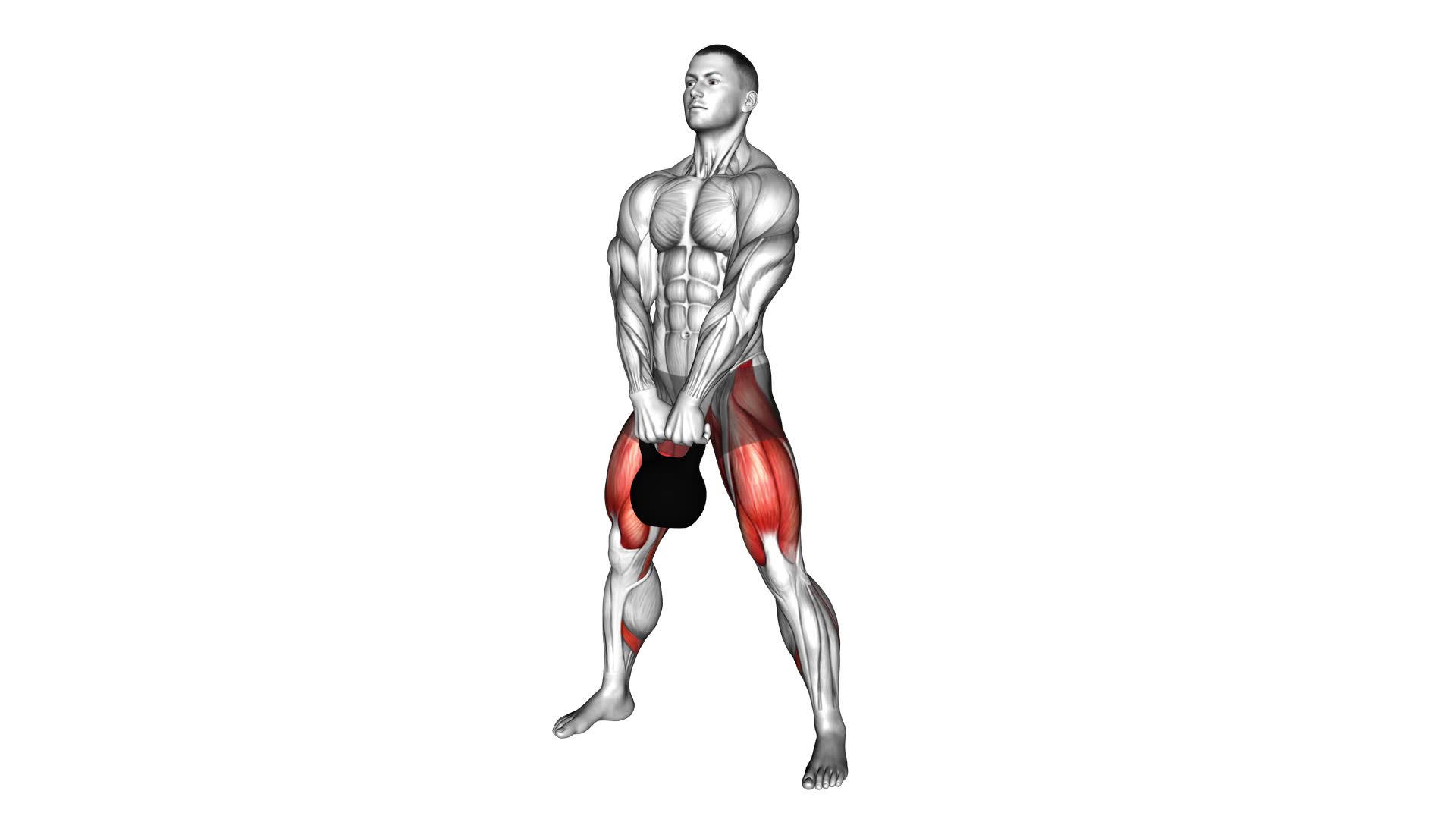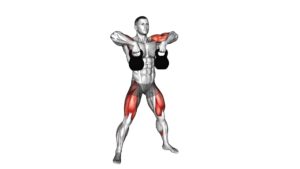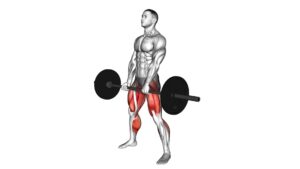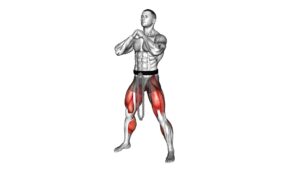Kettlebell Sumo Deadlift – Video Exercise Guide & Tips

Are you looking for a highly effective exercise that targets your glutes and legs? Look no further than the kettlebell sumo deadlift.
Watch This Exercise Video
This exercise, demonstrated in our video guide, engages multiple muscle groups and helps improve strength and stability.
By utilizing proper form and technique, you can maximize your results and avoid common mistakes.
Whether you're a beginner or an experienced lifter, our tips will help you get the most out of this powerful exercise.
Key Takeaways
- Targets glutes, hamstrings, and quads
- Engages core muscles
- Improves strength and stability
- Can be incorporated into any workout routine
Benefits of the Kettlebell Sumo Deadlift
You can experience numerous benefits from incorporating the Kettlebell Sumo Deadlift into your workout routine. This exercise primarily targets the muscles in your lower body, particularly the glutes, hamstrings, and quads. It also engages your core muscles, including the abdominals and lower back. By incorporating the kettlebell sumo deadlift into your workout routine, you can effectively strengthen and tone these muscle groups.
To incorporate the kettlebell sumo deadlift into your workout routine, start by standing with your feet wider than shoulder-width apart and toes pointed outwards. Place a kettlebell on the ground between your feet. Bend at the hips and knees, keeping your back straight and chest lifted, and grip the kettlebell with both hands. Engage your core and lift the kettlebell by straightening your legs and driving your hips forward. Keep your arms straight as you lift the kettlebell, and then lower it back down to the ground with control.
To maximize the benefits of the kettlebell sumo deadlift, aim for 3 sets of 10-12 repetitions. Start with a lighter weight kettlebell and gradually increase the weight as you build strength and confidence. Remember to always maintain proper form to prevent injury and get the most out of this exercise.
Proper Form and Technique
Maintain a strong and stable position throughout the kettlebell sumo deadlift by keeping your back straight, chest lifted, and core engaged. Proper form and technique are crucial to ensure safety and maximize the benefits of this exercise.
Here are some important points to remember:
- Common Mistakes:
- Rounded back: Avoid rounding your back as it puts excessive strain on your spine. Keep your back straight throughout the movement.
- Dropping the chest: Maintain a lifted chest to prevent your upper body from collapsing forward.
- Lack of core engagement: Engage your core muscles by bracing them as if someone is about to punch you in the stomach. This helps stabilize your entire body during the lift.
- Proper Technique:
- Start with your feet wider than shoulder-width apart and toes pointed slightly outward.
- Grab the kettlebell handle with both hands and position it between your legs.
- Bend your knees and hinge at the hips, lowering your torso while keeping your back straight.
- Drive through your heels, extend your hips, and straighten your legs to lift the kettlebell.
- Squeeze your glutes at the top of the movement and then slowly lower the kettlebell back down.
Variations and Modifications
To add variety to your kettlebell sumo deadlift routine, consider incorporating different variations and modifications.
Sumo deadlift variations can help target different muscles and add new challenges to your workout. One variation is the single-leg sumo deadlift, where you perform the exercise on one leg while keeping the other leg elevated behind you. This variation increases the demand on your stabilizing muscles and improves balance.
Another variation is the sumo deadlift high pull, where you explosively pull the kettlebell up to shoulder height, engaging your upper body muscles along with your lower body.
Modified sumo deadlifts can also provide a different stimulus to your routine. One modification is the kettlebell suitcase deadlift, where you hold the kettlebell by your side instead of between your legs. This variation shifts the focus to your core and grip strength.
Another modification is the kettlebell sumo squat, where you perform a squat instead of a deadlift motion. This variation targets your glutes and quadriceps more intensely.
Tips for Maximizing Results
Maximize your results with these key tips for the kettlebell sumo deadlift.
To ensure you're optimizing your workout and maximizing gains, follow these expert recommendations:
- Maintain proper form: Keep your back straight, engage your core, and hinge at the hips to avoid injury and target the correct muscles.
- Choose the right weight: Select a kettlebell that challenges you without compromising your form. Gradually increase the weight as you get stronger to continue making progress.
- Focus on your breath: Inhale as you lower the kettlebell and exhale as you lift it, utilizing your breath to generate power and stability.
By following these tips, you can enhance the effectiveness of your kettlebell sumo deadlift and achieve better results. Remember to listen to your body and adjust accordingly. Happy lifting!
Common Mistakes to Avoid
Avoid these common mistakes when performing the kettlebell sumo deadlift to ensure optimal results. Correcting technique and avoiding injuries are crucial for a safe and effective workout.
First, make sure to maintain a neutral spine throughout the movement. Avoid rounding your back or arching it excessively, as this puts unnecessary strain on your spine. Engage your core muscles and imagine pulling your shoulder blades down and back to maintain proper alignment.
Another mistake to avoid is using too heavy of a weight. Start with a lighter kettlebell and focus on perfecting your form before increasing the load. This will help prevent injuries and allow you to progress gradually.
Additionally, be mindful of your foot placement. Your feet should be wider than shoulder-width apart, with your toes pointed slightly outward. This wide stance provides a stable base and allows for proper activation of your glutes and hamstrings.
Lastly, avoid rushing through the exercise. Take your time to lower the kettlebell down and drive through your heels to stand up. Maintain control throughout the entire movement, focusing on engaging the correct muscles.
Frequently Asked Questions
What Is the History or Origin of the Kettlebell Sumo Deadlift?
The history of the kettlebell sumo deadlift dates back to ancient times. It originated as a functional exercise to build strength and power in the lower body. Over the years, it has become popular due to its numerous benefits.
This exercise targets the glutes, hamstrings, and quadriceps, helping to improve overall leg strength and stability. Additionally, it can enhance grip strength and promote better posture.
Incorporate this exercise into your routine for maximum results.
Can the Kettlebell Sumo Deadlift Help With Weight Loss?
The kettlebell sumo deadlift is a great exercise to incorporate into your weight loss routine. By utilizing a wide stance and holding the kettlebell between your legs, you engage multiple muscle groups, including your glutes, quads, and hamstrings.
This exercise not only helps to build strength and increase muscle tone, but it also promotes fat loss by burning calories and boosting your metabolism.
Proper technique is key to maximizing the benefits of the kettlebell sumo deadlift.
What Muscles Does the Kettlebell Sumo Deadlift Primarily Target?
The kettlebell sumo deadlift is a great exercise for targeting multiple muscle groups. It primarily focuses on your glutes, quadriceps, hamstrings, and lower back. By incorporating this exercise into your workout routine, you can strengthen and tone these key areas.
Additionally, the sumo stance used in this deadlift variation also engages your core muscles, providing you with a full-body workout.
How Does the Kettlebell Sumo Deadlift Compare to the Traditional Barbell Deadlift?
When comparing the kettlebell sumo deadlift to the traditional barbell deadlift, there are a few key differences to consider.
The kettlebell sumo deadlift targets similar muscle groups, such as the glutes, hamstrings, and quadriceps, but it also engages the core and upper back more intensely.
Additionally, the kettlebell sumo deadlift is a great exercise for weight loss due to its high calorie burn and ability to increase heart rate.
Are There Any Specific Warm-Up Exercises Recommended Before Performing the Kettlebell Sumo Deadlift?
Before performing the kettlebell sumo deadlift, it's important to warm up properly. Start with some dynamic stretches like leg swings and hip circles to loosen up your lower body.
You can also do some bodyweight squats and lunges to activate the muscles you'll be using during the exercise.
Warm-up exercises help increase blood flow, improve flexibility, and reduce the risk of injury. So don't skip them!
Conclusion
In conclusion, the kettlebell sumo deadlift is a highly effective exercise for building strength and targeting the lower body muscles. By following proper form and technique, you can maximize the benefits of this exercise and avoid common mistakes.
Incorporating variations and modifications can also help keep your workouts challenging and prevent plateaus. By implementing these tips, you can optimize your results and achieve your fitness goals efficiently.

Author
Years ago, the spark of my life’s passion ignited in my mind the moment I stepped into the local gym for the first time. The inaugural bead of perspiration, the initial endeavor, the very first surge of endorphins, and a sense of pride that washed over me post-workout marked the beginning of my deep-seated interest in strength sports, fitness, and sports nutrition. This very curiosity blossomed rapidly into a profound fascination, propelling me to earn a Master’s degree in Physical Education from the Academy of Physical Education in Krakow, followed by a Sports Manager diploma from the Jagiellonian University. My journey of growth led me to gain more specialized qualifications, such as being a certified personal trainer with a focus on sports dietetics, a lifeguard, and an instructor for wellness and corrective gymnastics. Theoretical knowledge paired seamlessly with practical experience, reinforcing my belief that the transformation of individuals under my guidance was also a reflection of my personal growth. This belief holds true even today. Each day, I strive to push the boundaries and explore new realms. These realms gently elevate me to greater heights. The unique combination of passion for my field and the continuous quest for growth fuels my drive to break new ground.







